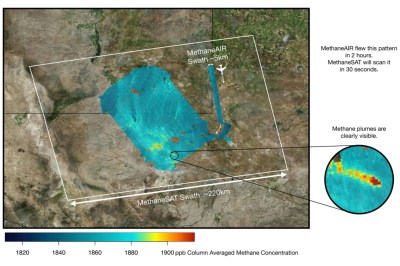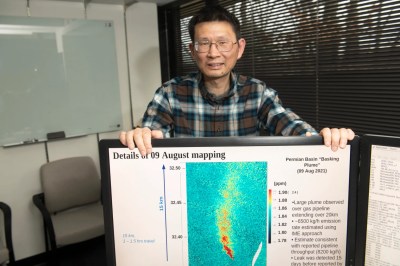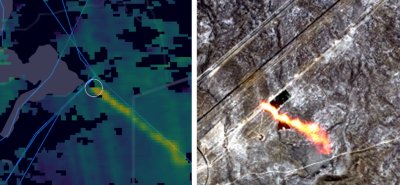Much of the reporting around climate change focuses on carbon dioxide. It’s public enemy number one when it comes to gases that warm the atmosphere, as a primary byproduct of fossil fuel combustion.
It’s not the only greenhouse gas out there, though. Methane itself is a particularly potent pollutant, and one that is being emitted in altogether excessive amounts. Satellites are now on the hunt for methane emissions in an attempt to save the world from this odorless, colorless gas.
BAD GAS
Methane stands out as an extraordinarily effective greenhouse gas, carrying a warming impact 28 times greater than that of CO2 on a weight-for-weight basis over 100 years. Prior to industrialization, it primarily originated from natural reservoirs, such as microbes breaking down organic matter in still bodies of water, or from melting permafrost.
Today, contemporary scientific consensus suggests that roughly 60% of the methane present in the atmosphere can be attributed to human actions. The agricultural sector plays a significant role, as livestock, especially ruminants, are significant producers of methane. As the global appetite for meat and dairy products shows no signs of decreasing, this source of emissions presents a challenging obstacle. Beyond farming, waste management facilities and sewage treatment plants release considerable amounts of methane. The substance is frequently a byproduct of both oil and gas extraction operations. Leaks from industrial facilities and municipal natural gas systems are not uncommon.
Historically, the concentration of methane in the atmosphere has been relatively small in comparison to carbon dioxide. However, recent years have seen levels rise beyond previous expectations, which could pose a challenge for the world’s efforts to stem rising global temperatures.
HUNT FROM THE SKIES
The fact of the matter is that you can’t quash what you can’t see. Without knowing where increased methane output is coming from, it’s hard for researchers and administrators to know where to start fixing the issue. Thankfully, there are tools that can help track down sources of methane emissions.

MethaneSAT is the headline project in this area. Scheduled to launch in early 2024, the satellite is the result of a collaboration between Harvard researchers, private space companies, activists, philanthropists, and the coordinating Environmental Defense Fund. Typically, full-scale satellite design and launches are the purview of multi-billion-dollar companies and governments alone, but MethaneSAT has been developed by a coalition on a mission. Principle investigator Steven Wofsy noted the group’s hard work to make the project a reality after he costed the project at tens of millions of dollars. “We brought that back to EDF, and we assumed that that was the end of it,” Wofsy said. “But they went ahead and raised enough in private philanthropy to fund this thing.”

The goal of MethaneSAT is to allow monitoring a wide area for sources of methane emissions far more quickly and easily than existing aerial- and ground-based methods. The prime instrument on the satellite is a spectrometer. As light reflected from the ground passes through the atmosphere, the spectrometer can capture the telltale signature of methane in the spectrum of light it receives. A plume of methane in the air from a landfill, farm, or pipeline leak will become readily apparent as the satellite passes over. When leaks and strong sources are identified, then something can be done about it.
EXISTING WORK

MethaneSAT won’t be the only game in town when it launches in early 2024. Other researchers have already been using satellites to monitor methane emissions around the world.
Recent surveys by NASA have shown “mind-boggling” emissions of methane from fossil fuel fields in Turkmenistan. The methane releases were so great, they effectively equalled the UK’s total annual emissions in equivalent tons of CO2. Suspicions are that operators in the area may be simply venting methane to the atmosphere now that “flaring,” or burning off excess methane, is frowned upon. Due to the potency of methane as a greenhouse gas, this is actually far worse for the climate.
The European Sentinel 5P satellite has also been put to work on this task. Using the Tropomi, or Tropospheric Monitoring Instrument, on the craft, researchers identified broad areas of interest that could be a source of higher methane emissions. The data revealed gas leaks from wells in the US, as well as emissions from pipelines feeding gas from Russia to Europe. These hotspots can also be used guide investigations with more precise satellites run by Canadian operator GHGSat, researchers can identify sources of methane emissions down to a resolution of 20 meters or so.
THE FIRST STEP
Satellites are a great tool to hunt for methane emissions. Sadly, though, finding leaks and heavy emitters is just the first step in solving the problem. The real hard work starts when it comes time to fix leaks and reduce excessive pollution from industrial sources. As always, knowing is half the battle.



